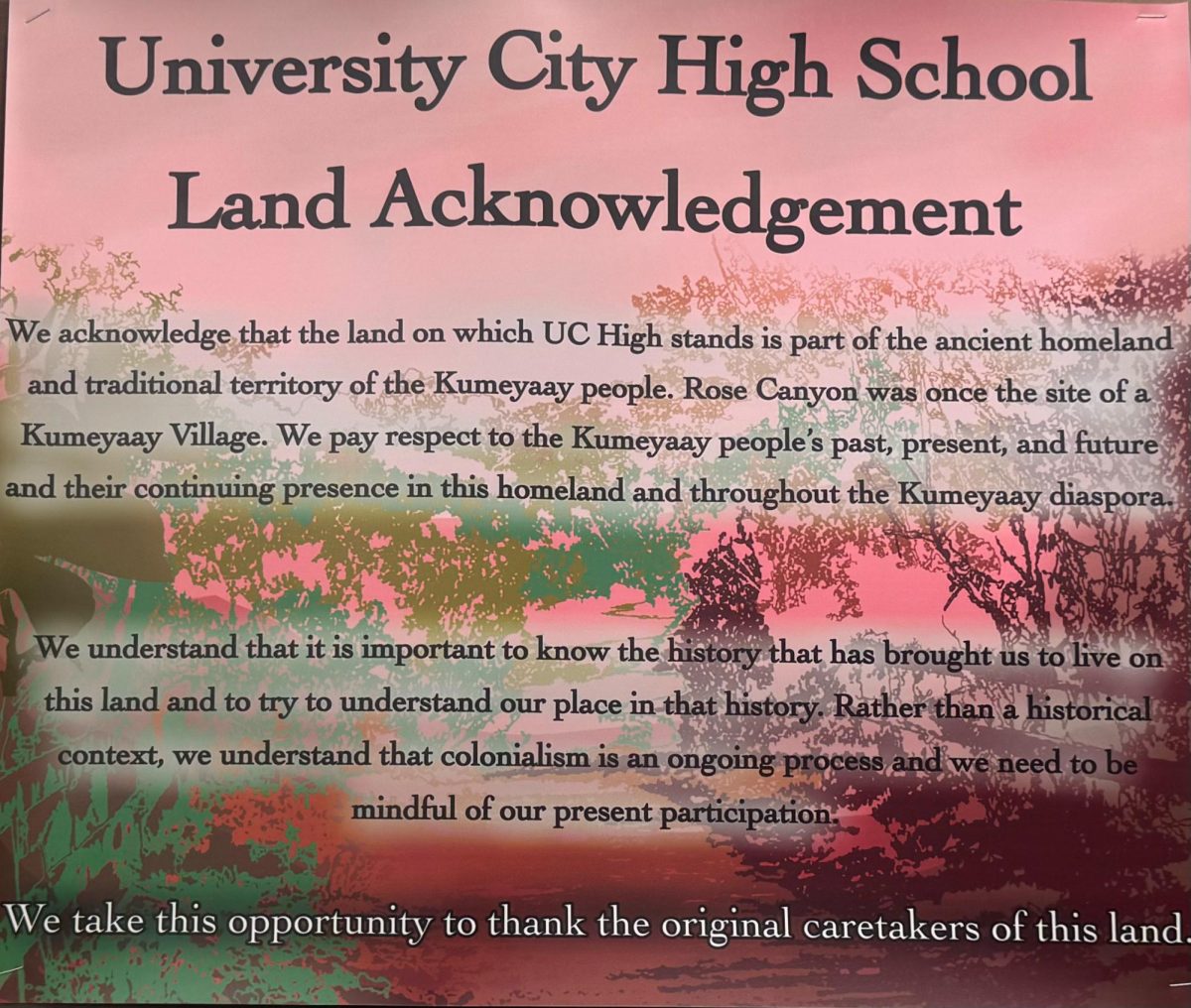We have all heard it by now, UC High’s Land Acknowledgement. It’s read aloud at all of the assemblies, and hung on the walls of every classroom. An abridged version is even on the school’s website, located at the very bottom of the homepage in a collapsed box that displays four sentences in small print when clicked on.
Land acknowledgements have gained popularity in recent years, especially since 2020, and UC High embraced the trend, creating its own. These statements are usually centered on local Native nations, in the hopes that they will encourage discussion and community participation. UC High’s Land Acknowledgement that includes the Kumeyaay people is clearly well-intentioned, but how much good does it really do? Has it actually created any engagement with or benefit for Kumeyaay communities? Unfortunately, it hasn’t led to any real change.
In order for words to mean something and make a difference, there has to be action behind them. UC High’s Land Acknowledgement states, “We understand that colonialism is an ongoing process and we need to be mindful of our present participation.” UC High acknowledges that colonialism is a current, ongoing problem that people should be mindful of, and yet, aside from this land acknowledgment, there’s no real action being taken to combat it or connect with Native American communities. There’s no plan for reparations, no clubs, no assemblies, and no resources provided for students to learn about the Kumeyaay, even on UC High’s website. This land acknowledgement has existed for a number of years, years in which great strides could have been made. UC High claims to care about this issue, but all it has done is rewrite the same short paragraph.
Of course, as a public school, UC High is limited in what it can do in terms of helping the Kumeyaay. As a government-run school, it can’t just decide on its own to give the land on which it’s situated back to the native Kumeyaay. That’s not to say that it doesn’t have options, however.
While land or monetary reparations are realistically completely off the table, UC High has the power to influence and connect people. If UC High actually committed to using some of this power to educate students about the Kumeyaay, it could do a lot of good. There should at least be easily-accessible resources. Special Education Teacher Samantha Cruz, who led the Equity Team and was one of the teachers who oversaw the creation of the land acknowledgement, said, “I recall in elementary school, here in SDUSD, going to visit and learn about the native Kumeyaay. Let’s bring that back, for all grade levels in different manners. The best way for us to learn about others is to engage with them and be active participants.”
UC High’s mental health fair started just two years ago. Why couldn’t there be something like that, but focused on Kumeyaay history and current ways to get involved with their communities? At the very minimum, there should be a QR code or a link to a website to learn more about the Kumeyaay included with the land acknowledgement. “I think we should always be doing more,” stated School Connections Specialist Tina Medina.
Ethnic Studies Resource Teacher Brian Batugo, who works with San Diego Unified School District, agreed that land acknowledgements need to have real action to go alongside them, and said, “At San Diego Unified, we believe it’s important these acknowledgements don’t just stand alone, but connect to relationships and action with Native partners.” Although members of district administration show a clear understanding that these acknowledgments lack substance, no progress has been made to create any material significance.
One might argue that the land acknowledgment is good enough, as it does reach a lot of people, who may then decide to go out and learn more about and engage with the Kumeyaay community on their own. This argument is flawed, however. We say the Pledge of Allegiance every Monday, much more often than the land acknowledgement, and yet nobody talks about civic participation, or patriotism, or anything related to it. It’s just a formality that is gotten out of the way before being promptly forgotten about. The land acknowledgement is unfortunately relegated to a similar position. There’s no real discussion or involvement with the issues it relates to.
It’s just something that’s quickly read over, and then promptly forgotten about. Quickly say the pledge, then get on with the lesson. Quickly say the land acknowledgement, then get on with the assembly. This kind of blind recitation doesn’t actually educate students or help the Kumeyaay. Senior Rudy Galvan, who has attended UC High for three years, all years in which the land acknowledgement has existed, agrees with this sentiment, and stated, “It’s cool that UC High is open to acknowledging the land; however, I believe it doesn’t signify or imply any major changes in or for the community.”
So why doesn’t UC High try to use its land acknowledgement as a stepping stone for greater change? If it really cared about this issue, then that’s what it would do, after all. The school wants the social credit that comes from being seen as a beacon for Native American justice and equity, but hasn’t taken the steps to contribute to that, leaving the land acknowledgement to be remembered only in passing. The land acknowledgement is everywhere, but the actual change is nowhere to be found.

